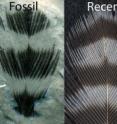Fossil feathers preserve evidence of color, say Yale scientists
The traces of organic material found in fossil feathers are remnants of pigments that once gave birds their color, according to Yale scientists whose paper in Biology Letters opens up the potential to depict the original coloration of fossilized birds and their ancestors, the dinosaurs. Closer study of a number of fossilized bird feathers by Yale PhD student Jakob Vinther revealed that organic imprints in the fossils — previously thought to be carbon traces from bacteria — are fossilized melanosomes, the organelles that contain melanin pigment.
"Birds frequently have spectacularly colored plumage which are often used in camouflage and courtship display," said Vinther. "Feather melanin is responsible for rusty-red to jet-black colors and a regular ordering of melanin even produces glossy iridescence. Understanding these organic remains in fossil feathers also demonstrates that melanin can resist decay for millions of years."
Working with Yale paleontologist Derek E. G. Briggs and Yale ornithologist Richard O. Prum, Vinther analyzed a striped feather found in 100 million-year-old rocks from the Lower Cretaceous Period in Brazil. The team used a scanning electron microscope to show that dark bands of the feather preserved the arrangement of the pigment-bearing structures as a carbon residue — organized much as the structures are in a modern feather. The light bands showed only rock surface.
In another fossil of a bird from the Eocene Epoch — 55 million years ago — in Denmark there were similar traces in the feathers surrounding the skull. That fossil also preserved an organic imprint of the eye and showed structures similar to the melanosomes found in eyes of modern birds.
"Many other organic remains will presumably prove to be composed of melanin," said Vinther. He expects that fur of ancient mammals and skin from dinosaurs preserved as organic imprints will likely be the remains of the melanin.
"Now that we have demonstrated that melanin can be preserved in fossils, scientists have a way to reliably predict, for example, the original colors of feathered dinosaurs," said Prum, who is the William Robertson Coe Professor of Ornithology and chair of the Department of Ecology and Evolutionary Biology, as well as curator of ornithology at Yale's Peabody Museum of Natural History.
Source: Yale University
Other sources
- Cosmic Log: A dinosaur’s true colorsfrom MSNBC: ScienceWed, 9 Jul 2008, 19:21:27 UTC
- Fossil feathers preserve evidence of colorfrom PhysorgWed, 9 Jul 2008, 9:14:08 UTC
- Fossil Feathers Preserve Evidence Of Color, Say Scientistsfrom Science DailyWed, 9 Jul 2008, 2:28:13 UTC
- Fossilized feathers may hold a trace of colourfrom News @ NatureWed, 9 Jul 2008, 0:35:14 UTC
- Fossil feathers reveal their huesfrom BBC News: Science & NatureTue, 8 Jul 2008, 23:29:00 UTC
- Feather Fossils Could Yield Dinosaur Colorsfrom Live ScienceTue, 8 Jul 2008, 22:42:13 UTC

